ASUS N53JF: Midrange 15.6” 1080p, Take Four
by Jarred Walton on December 28, 2010 1:40 AM ESTThe N53JF’s LCD: Not Up to Snuff
After going three-for-three on 1080p 15.6” LCDs being good quality, the ASUS notebook sadly ends our streak. Maximum brightness is just above 200nits, which isn’t too good if you’re trying to use it outdoors. The contrast is even worse, checking in at 233:1. We’ve seen plenty of laptops with even worse contrast ratios, but none of them were 1080p LCDs. Color accuracy is at least decent, and color gamut in some respects is better suited to general use than the high gamut displays. We’ve added the sRGB percentage of the Adobe 1998 color space to illustrate this point: 69% of ARGB is basically “ideal” for sRGB use, though in practice I still prefer slightly higher gamuts. Apple’s 77% is probably optimal for casual users.
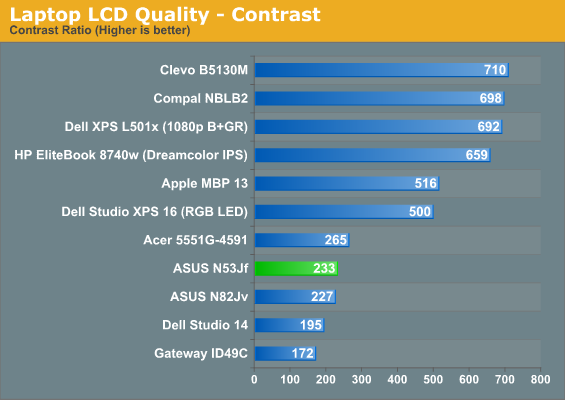
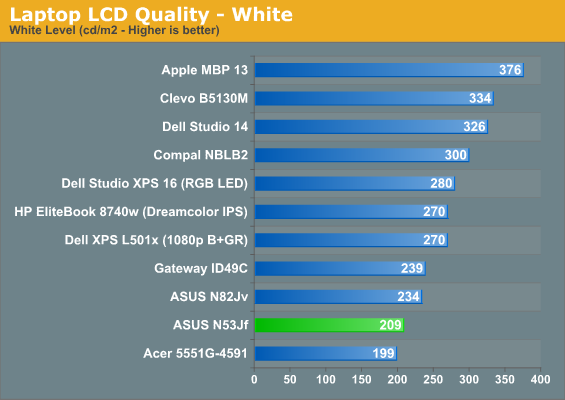
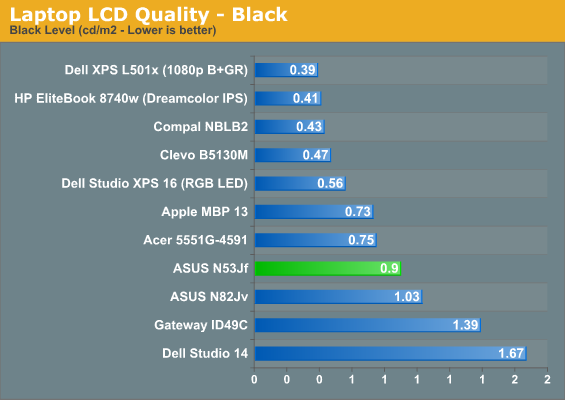

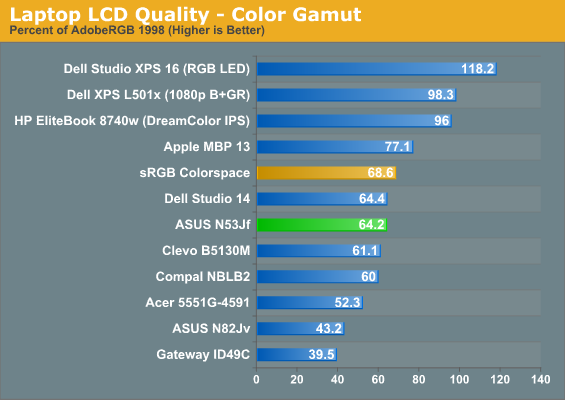
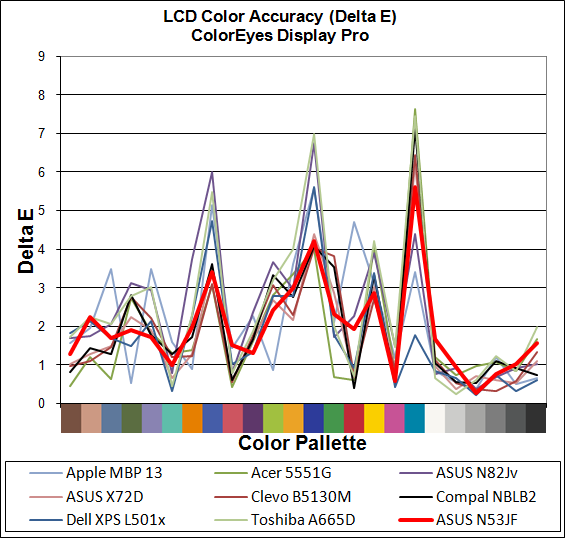
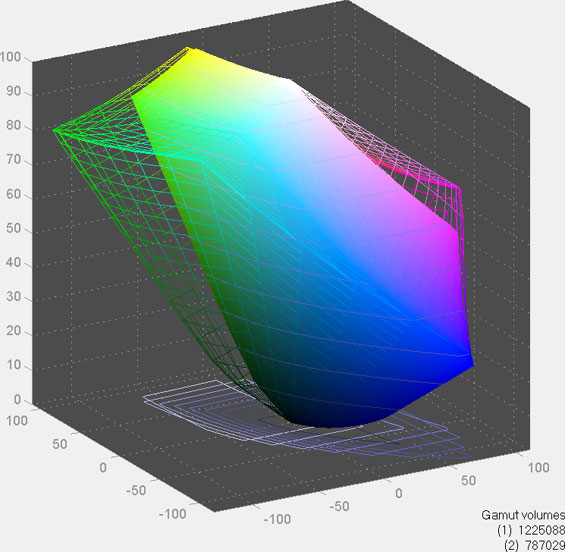
Viewing angles are standard TN panel fare, with severe color shifts from above and below. Nothing new to report here.
Heat and Noise Levels
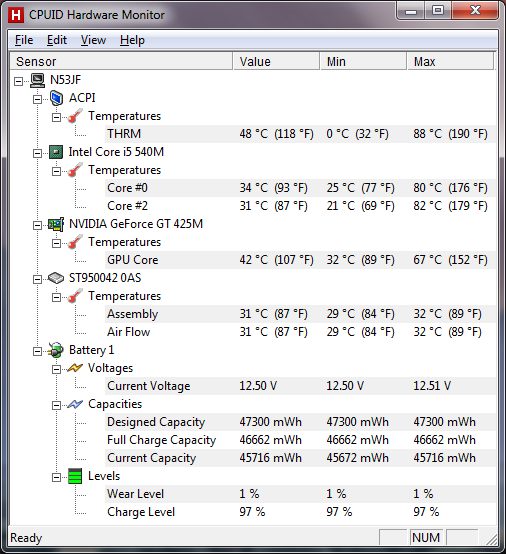
Using our standard stress test of 3DMark06 looping (with some x264 encoding running in the background), final system temperatures hit 82C on the CPU and 67C on the GPU. (ACPI reports a temperature of 88C, but I’m not sure what that’s measuring or if it’s accurate.) Surface temperatures are also fine and are similar to the other midrange notebooks we’ve tested. Idle temps ranged from 25-28C on the palm rest and keyboard, while the bottom is slightly warmer at 25-31C. Under our stress test, the top surfaces hit 25-32C and the bottom 25-38C, with the hottest areas near on the exhaust on the left side. Noise levels are also decent, with idle noise near the 30dB floor of our test equipment and environment but coming in just above that with 31dB; load noise is particularly good, reaching a maximum of just 36dB (measured from 12” in front of the notebook).
















65 Comments
View All Comments
anactoraaron - Tuesday, December 28, 2010 - link
That they would pack in USB 3.0, bluray and then put in that below average 1080p display. Not that it matters with Sandy Bridge on the horizon. Best advise is still to wait.ET - Tuesday, December 28, 2010 - link
It's nice to see 1080p becoming more prevalent at this size laptop, but why can't we see some higher res displays at 20"+? I had a 19" 1600x1200 CRT eight years ago, and resolution hasn't gone up since then, and even dropped from 1920x1200 to 1080p in recent times. Laptops these days have some high DPI displays and I'd love to see some on the desktop.Ushio01 - Tuesday, December 28, 2010 - link
1920x1080 monitors are replacing 1680x1050 TN panels in the mid range monitor segment just as 1680x1050 replaced 1280x1024 monitors with the advantage of either 120hz TN or IPS screens. 1920x1200 monitors still exist and are just as expensive as always along with the 2560x1440 and 2560x1600 in the high and very high end segments.jabber - Tuesday, December 28, 2010 - link
1080p will be a curse for us all in a couple of years time.Never will a standard have been surpassed and found wanting so quickly.
They should have made it 1440p at least.
Now us computers users have to suffer from the display world being lazy and sticking to a screen depth not much more that what we were used to 10 years ago.
Thats progress.
DanNeely - Tuesday, December 28, 2010 - link
I think the main bottleneck for the resolution picked for the HD standard was the capacity of dtv broadcast/blueray/hddvd disks without any compression artifacts. Bumping the frame sizes up 77% would have needed a significantly higher compression level and would've resulted in the videophiles who're currently reviling netflix/hulu/etc's streaming offerings for low quality to have slammed the new standards; potentially rendering them stillborn at birth, and almost certainly slowing adoption down significantly.The other hangup would be the size of the TV screen needed to get full use of the resolution in the living room. 1080p is generally not worthwhile on less than a 40" screen because the angular size of the pixels at 720p are too small to resolve at couch distance. The smaller pixels of a 1080p screen won't be visible as individual pixels until about 56". At the time the standards were being written 56" was an enormously large TV. It's still larger than most TVs sold today.
Until that changes (and bluerays, or the bandwidth needed to stream them at full quality, become commodity items) I don't expect anything to change on the consumer video market. When that happens I expect the new standard will be one of the 4k resolutions; probably either 3996×2160 (1.85:1) or 4096×1714 (2.39:1). We'd also need a higher density video cable standard. DP 1.2 will carry the 2d version of either signal, but would need doubled again to support 3d. Hopefully lightpeak will be mainstream by then and able to carry the data.
TegiriNenashi - Tuesday, December 28, 2010 - link
2.39:1 ? That is insane.DanNeely - Tuesday, December 28, 2010 - link
It's the wide-wide screen mode at theaters today. IT would render all but the largest desktop computer displays too short to be useful for anything except consuming content. The video industry would see this as a feature.TegiriNenashi - Tuesday, December 28, 2010 - link
I don't think letterbox has any future in the movie industry itself. Avatar 3D was rendered at 1.78 : 1. Let the 2.39:1 die, the sooner the better!Hrel - Tuesday, December 28, 2010 - link
here hereJarredWalton - Tuesday, December 28, 2010 - link
Hear, hear?